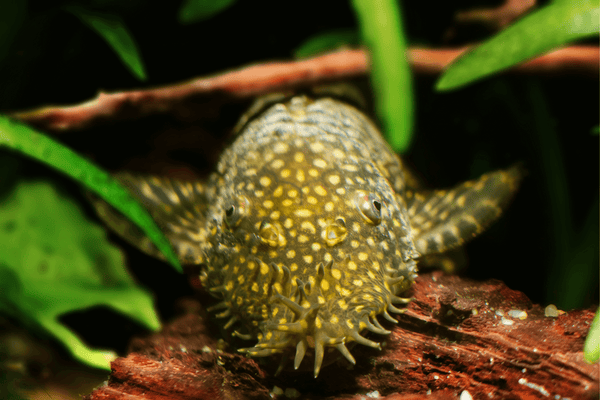"Pleco" is the name commonly used to refer to a wide variety of catfish (Loricariids), which have armor-like plates and suckermouths. These freshwater catfish are known to be algae eaters, bottom feeders, and scavengers that will eat just about anything, making them a helpful addition to an aquarium.
Originating in Central and South America, there are countless kinds of Plecos/catfish. The most popular pet species are the Suckermouth Catfish (Hypostomus plecostomus) and Bristlenose Catfish (Ancistrus dolichopterus).
With proper care, Plecos can live up to 20 years, and sometimes longer!

The Aquarium
Plecos are sold quite small in pet stores, so most people don’t realize that they will grow to reach 1 to 2 feet in length. As your Pleco grows larger, be prepared to house it in a 50-100 gallon aquarium. An older, larger Pleco may need a tank size closer to 150-200 gallons. Although Plecos can be housed with a wide variety of fish, they are very territorial towards their own species. As a result, it’s best to be safe and only keep one Pleco per tank.
Even with a large tank, it’s important to avoid overcrowding your Pleco. Fish should have enough room in the tank to have their own territories. This will help avoid negative interactions. Avoid housing your Pleco with flat-bodied fish as it can cause damage with its mouth.
Plecos can scratch an acrylic tank with their mouths, so your Pleco should be housed in a glass tank with dependable water parameters and proper filtration. Plecos are used to living in moving water and won’t thrive in water that lacks circulation and flow.
Finally, Plecos are agile jumpers. Be sure to purchase a securely-fitted lid for your tank.
 Decoration/Habitat
Decoration/Habitat
A habitat is an important aspect of pet care for any animal, and it’s no different for Plecos. A barren tank will stress your fish and make it shy and bored. Plecos need hiding spots throughout the tank where they can stay during the day because they’re nocturnal. Hiding spots can be created using all sorts of aquarium decorations like caves, tunnels, dark pipes, wood, and artificial plants.
Substrate, like pebbles or gravel, is a must for Plecos since they spend much of their time combing over sediment and debris looking for food. Wood should be included in your habitat for your Pleco to chew on. Many freshwater hobbyists say that wood helps balance the pH in the tank.
Choose sturdy, fast growing live plants because Plecos are known to uproot or eat them. Bury the roots deeply and securely in your substrate. Artificial plants are safer for your pocket book.
Stable quality of water, temperature, and pH levels are critical to the health of your fish. You will need to purchase a freshwater testing kit and make sure your tank has stable temperature (72-82 deg. F) and pH (6.5-7.5) before adding any fish to it.
Maintenance- Every Day
- Check the water temperature and filter
- Turn the lights on in the morning and off every night
- Feed your Pleco every 1-2 days
- Weekly
- Check the water quality and pH with a freshwater testing kit
- Give your Pleco vegetables 1-2 times a week
- Monthly
- Depending on the size of your tank, you should change 15-20% of the water 1-2 times per month (the smaller the tank or less filtration, the more often you'll need to do water changes). Here’s some more in-depth information about freshwater tank care and water changes.
- Water temperature: 72-82 degrees F
- pH-value: 6.5 and 7.5
- Plecos prefer semi-soft water (not too soft as that can cause a pH crash)
- Plecos prefer highly oxygenated water with strong flow and filtration
Because Plecos are nocturnal, the best time to feed them is just before you turn the light off at night. This is the best way to avoid other fish-eating the Pleco's food.
While Plecos do eat detritus and algae, it will still need its diet supplemented. Feed your Pleco every day or every other day with Pleco-specific food. One to two times per week, feed your Pleco pieces of cucumber, zucchini, or lettuce (not iceberg).

Heating & Lighting
It’s important for your Pleco’s health that you replicate the natural rising and setting of the sun. Turn on your aquarium lights every morning and turn them off every evening, or buy a lighting timer that manages it for you.
While Plecos aren’t likely to come out during the day, you can increase the chance of seeing them during the day by dimming the aquarium lights in the morning or evening, or by adding floating plants that will block some of the light.
The temperature in the aquarium should be kept between 72-82 degrees F at all times.
Shopping List
- 50-100 gallon glass aquarium
- Secure screen lid
- Filtration system
- Water quality (and pH) testing kit
- Tank heater
- Tank thermometer
- Lighting
- Lighting timer (optional)
- Substrate
- Hides (caves, tunnels, tubes, etc.)
- Wood
- Artificial and/or real plants
- Pleco food
- Circulation fan (depends on filtration flow and size of tank)
Signs of a Healthy Pleco
- Vigorous appetite
- Clear eyes
- Remains on or near the tank bottom or the side of the aquarium and decor
- cloudy eyes
- fraying fins
- color loss
- breathing problems
- spots on the body
- feeding during the day - more than occasionally
Common health problems include Cloudy Eye and Ich. Improving the water quality is often an adequate solution for Cloudy Eye. For Ich, you will need to quarantine your Pleco right away and use a medicated solution for around two-three weeks.
This outline is meant to be simple guide to Pleco care. For more information or advice on health problems, please consult a fish expert, your veterinarian, or more in-depth online resources.
 Decoration/Habitat
Decoration/Habitat

